Upgrading and Analyzing Apple's Nehalem Mac Pro
by Anand Lal Shimpi on July 13, 2009 5:00 PM EST- Posted in
- Mac
Performance
Understanding how the new Nehalem Mac Pro performs really isn't that difficult; it all boils down to the type of workload. On very threaded workloads, the new Mac Pro should be much faster than the old one, even at a lower clock speed. Single threaded applications will show us the opposite - the new Mac Pro will need equivalent clock speed to equal the older one. And for everything in between, the wins will vary.
Adobe Photoshop CS4 Performance
To measure performance under Photoshop CS4 we turn to the Retouch Artists’ Speed Test. The test does basic photo editing; there are a couple of color space conversions, many layer creations, color curve adjustment, image and canvas size adjustment, unsharp mask, and finally a gaussian blur performed on the entire image.
The whole process is timed and thanks to the use of Intel's X25-M SSD as our test bed hard drive, performance is far more predictable than back when we used to test on mechanical disks.
Time is reported in seconds and the lower numbers mean better performance. The test is multithreaded and can hit all four cores in a quad-core machine.
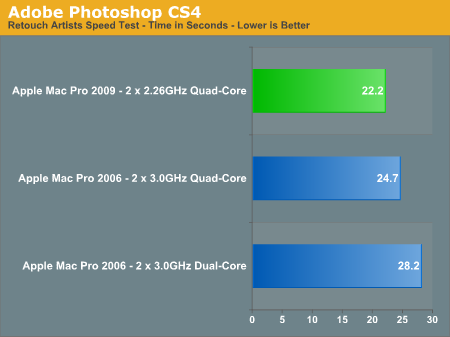
This test isn't heavily threaded from start to finish, some actions only stress one or two cores while others will drive all sixteen virtual threads on the new Mac Pro. The speedup from Hyper Threading is enough however to give the new Mac Pro an advantage, even at a lower clock speed, over the older model. This makes sense given how well the Nehalem based Core i7s do in our CS4 benchmark in Bench.
Apple Aperture 2.1.2 Performance
While Photoshop lets us do a lot of photo processing, Aperture is useful in managing workflow before we get to the heavy processing stages of Photoshop. For this test I'm exporting one of the sample albums that comes with Aperture from RAW to JPEG format.

The results here aren't uncommon. In a lightly threaded task you shouldn't expect the new Mac Pro to be faster than the old one, there's no replacement for clock speed. Other workloads will be hurt simply because L2 cache sizes are smaller with Nehalem then they were previously (only 256KB L2 per core with Nehalem).
Xcode Performance
Good compiler tests are hard to come by, but I've found that building the Adium source in Xcode is not only repeatable but a great test of platform performance. The build process is multithreaded and will use up to 16 threads, although not consistently over the course of the build.

Hyper Threading has the potential to really help the new Mac Pro if you're running a heavily threaded workload. The Xcode test is the perfect example of a real world usage scenario that doesn't max out all cores, but still does very well on the new Mac Pro.
Adobe Premier Pro CS4 Performance
Video encoding under Quicktime was a bust, but using a professional encoder like Premier Pro shows the strength of Nehalem:
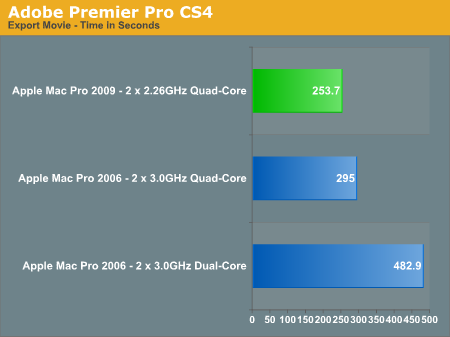
At 2.26GHz we're faster than eight cores running at 3.0GHz with the first Mac Pro. Throw in a pair of 2.93GHz Xeons and you'll see another ~20% performance improvement on top of that.
I would guesstimate that the quad-core 2.66GHz Mac Pro should deliver performance similar to (if not slightly slower than) the older 8-core 3.0GHz Mac Pro.
Quicktime H.264 Encoding Performance
While video encoding can definitely benefit from the monster threading abilities of the new Mac Pro, lighter encoding workloads don't really benefit:
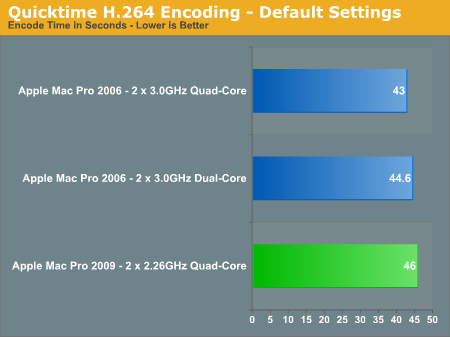
Quicktime is hardly the best application to do serious video encoding, here we see it barely scales beyond two cores - Nehalem has nothing to offer us in this sort of a situation.
iWork, iLife and General Use Performance
If you plan on using your Mac Pro for more than just rendering, encoding and computation, you'll find that it does work very well as a general use machine:

But clock speed definitely matters. In these two iWork benchmarks the 2.26GHz eight-core Mac Pro is measurably slower than its 3GHz predecessors. You'll at least need the 2.93GHz upgrade to equal their performance here.
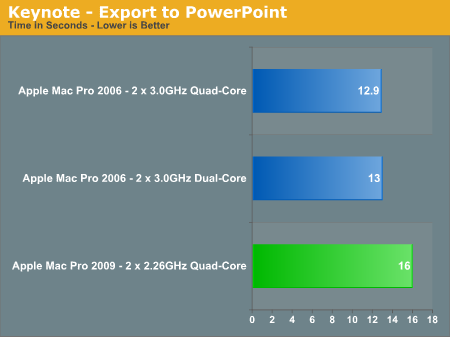
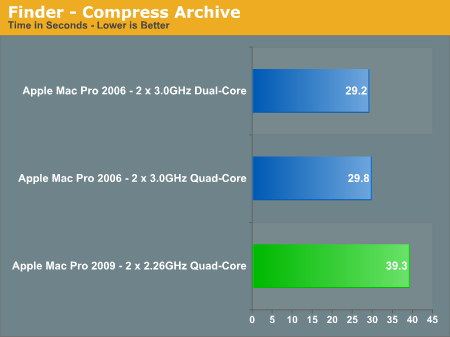
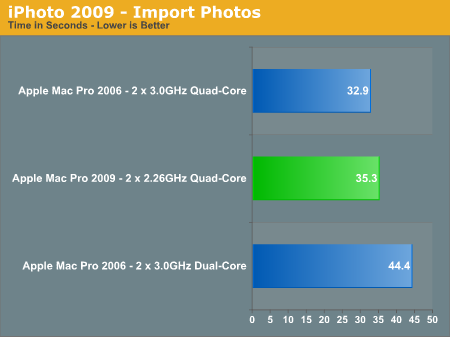










58 Comments
View All Comments
jamesst - Tuesday, July 14, 2009 - link
"The Lexar reader is FireWire 800 (woo!) and the iSight is FireWire 400; I can’t use the iSight on the new Mac Pro."You can still use your Firewire 400 iSight camera on the Mac Pro's Firewire 800 ports. All you need is a Firewire 400 to Firewire 800 cable. I know that Belkin makes just such a cable and I even purchased one at my local Apple Store here in Raleigh, NC.
joelypolly - Monday, July 13, 2009 - link
I have actually had something similar happen to a socket I was working on. It was a matter of finding a sewing needle and moving each "pin" back to the original position.HilbertSpace - Monday, July 13, 2009 - link
It would be interesting to try swapping the 2-socket tray with a 1-socket Mac Pro, and see if it works(?) Would be cheaper to buy the 2-socket board and upgrade yourself, no?MonkeyPaw - Monday, July 13, 2009 - link
Are FB-DIMMs going to disappear from the market? While at first it doesn't sound Mac-related, original MacPro owners might soon be running out of memory upgrade options (though I doubt they've held out this long to upgrade). It wasn't cheap to start with, but it seems like it was Band-Aid technology. The IMC was the answer, but FB-DIMMs were a stop-gap until Nehalem-Xeons could arrive. Perhaps a memorial article for the technology is needed?JimmiG - Monday, July 13, 2009 - link
Ok so I get it, even the "cheap" Mac Pro uses a Xeon, not an i7... But for all intents and purposes, it's an i7 920.Who in their right mind would pay $2,500 for a i7 920 system with 3GB of RAM, 640GB HDD and a rebranded Geforce 9500 GT? You can build a similar PC (or hackintosh) with the same specifications for the a fraction of the price - in fact you could also bump the RAM to 6GB and throw in a 1TB drive and a 4870 1GB or 4890 if you wanted and still stay *well* below that price point, even if using quality components and case.
The Mac Pro isn't even shiny!
plonk420 - Tuesday, July 14, 2009 - link
did you read page 10?MrDiSante - Thursday, July 16, 2009 - link
Did you read his comment?ltcommanderdata - Monday, July 13, 2009 - link
Another great in depth review. Your experiences with upgrading the processors were particularly interesting although I don't think it'd be something I would try.I just wanted to suggest you Boot Camp the Mac Pro and run the benchmarks needed to add 2x2.26GHz Gainestown and 2x2.93GHz Gainestown results to the Anandtech Bench. It might also be interesting to get a sample of the new nVidia GTX285 Mac Edition. It would certainly address the 1GB of VRAM concerns and would be cheaper than getting the HD4870 if you need 2 dual-link DVI ports since you don't need to buy that finicky adapter. There really aught to be DVI to mini-DP adapters though for people who still want to use the 24" LED display.
http://www.glbenchmark.com/result.jsp">http://www.glbenchmark.com/result.jsp
Oh and for interest, there turns out to be a 3D benchmark comparing the various iPhones to other cell phones. It's called GLBenchmark and needless to say, the iPhone 3G S is a screamer. They are also detecting the iPhone 3G S GPU as a PowerVR SGX 535.
ddobrigk - Monday, July 13, 2009 - link
Actually, the Nehalem-EX's octo-core possibility is a no-go for now. It is a future product and has not been launched yet.Also, a little bit of nitpicking, but it won't use LGA1366 like these Xeons, it'll use LGA1567, because each CPU will sport a 4-channel memory controller.
In addition, it'll sport 4 QPI links, and its intended target are 4-way and 8-way systems, not really 2-way systems. A few rumors exist about some integrators being interested in 2-socket systems, though we're still a few months from actually seeing any LGA1567 motherboard on display, AFAIK. All we saw was an Intel Demo about it.
Don't know if Apple intends to go with 2-socket nehalem-exs, anyway, because when Nehalem-EX really hits the market, there'll also be the 6-core westmeres, I think. In any case, we're way beyond a reasonable number of cores for the typical user. :D
BrianMCan - Friday, July 17, 2009 - link
MacPro's really aren't meant for typical users ;)Scientific, Video/Movies, 3D, and advanced users who may do many things including the already mentioned, or many things at once. Always other things I can be doing while some video is rendering, including playing some Civ 4, or starting the next video project, researching upgrades & repairs for customers, stuff like that.
Although I personally may wait for the 2nd gen Nehalem MacPro's before I upgrade from my first gen MacPro, other than raw processing power, it does most of what I need efficiently enough.